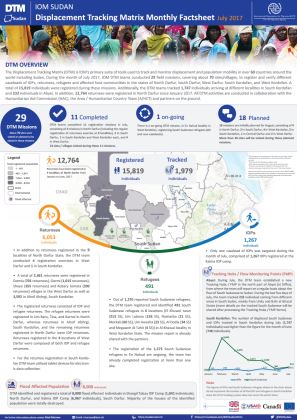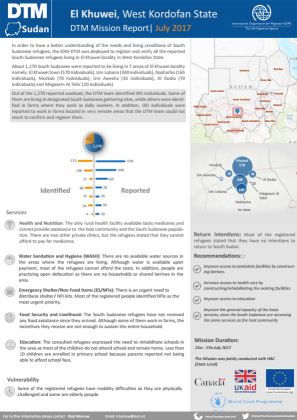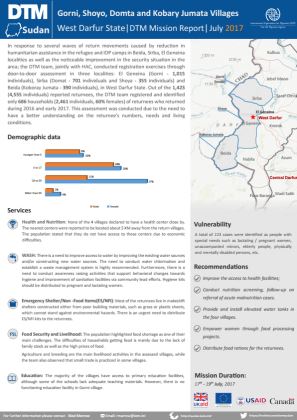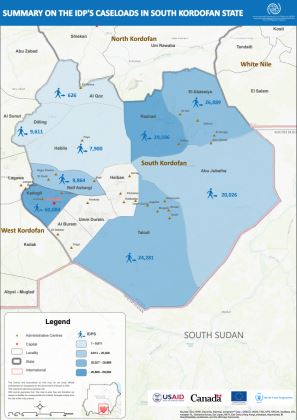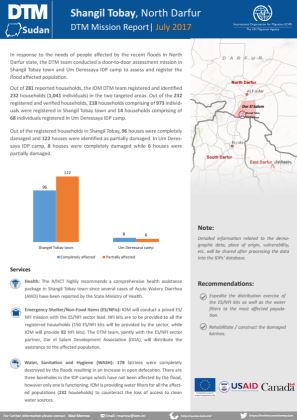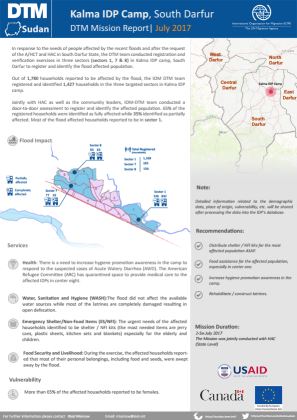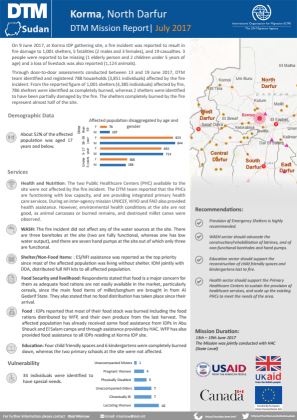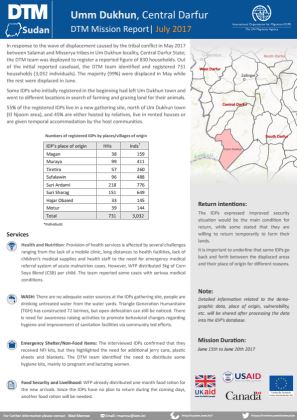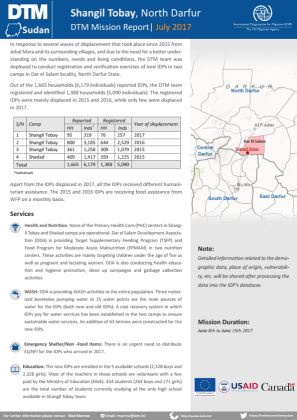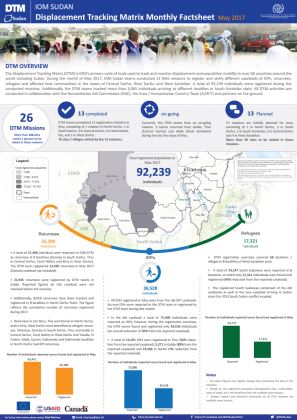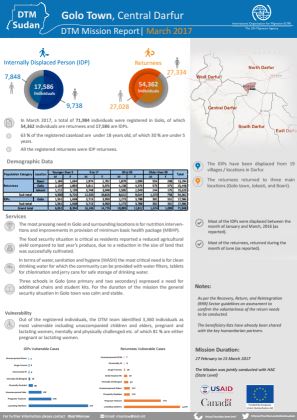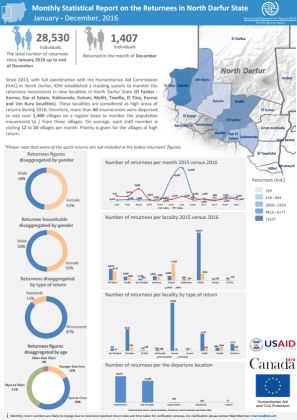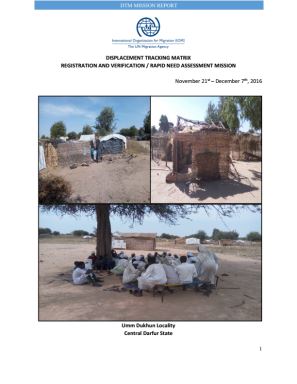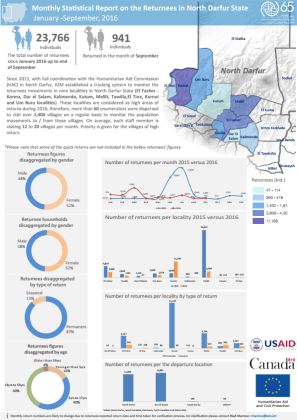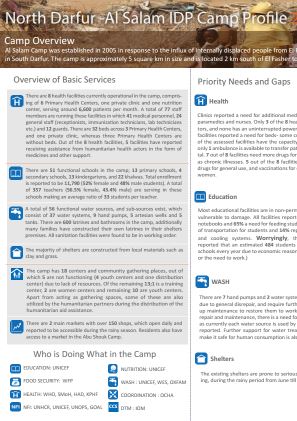-
Countries
-
Data and Analysis
-
Special Focus
-
Crisis Responses
Sudan
IDPs registered
Displacement Movements
3,553,000
IDMC 2022
Data collection round
About Sudan
DTM is a system to track and monitor displacement and population mobility. It is designed to regularly and systematically capture, process and disseminate information to provide a better understanding of the movements and evolving needs of displaced populations, whether on site or en route. Data collection strategies and tools are based on the DTM global methodology but have been adapted to reflect the context and population movements specific to Sudan.
In order to appraise the humanitarian community with primary data on displacement caseloads and dynamics, DTM currently employs over 300 field enumerators to engage with its wide key informant network spanning all of Sudan’s 18 states. Enumerators are employed based on their prior knowledge of their areas of concern, and are trained on DTM Sudan’s global data collection standard and methodologies. To stay up-to-date with DTM’s outputs, please join our mailing list here.
Since 2004, DTM Sudan has provided rapid emergency registrations with a priority of meeting immediate information needs for guiding direct assistance to vulnerable people. In 2010, DTM expanded to include biometric registrations and data verifications – implemented in response to government or humanitarian partner requests. Registration data is mission critical for site managers to undertake beneficiary selection, vulnerability targeting, and to inform broader humanitarian programming. Additionally, DTM Sudan is has operated one Flow Monitoring Point at Abyei – registering the arrival of South Sudanese into the country.
Commencing in November 2019, DTM Sudan expanded its operations to implement Mobility Tracking (MT) across an initial seven states – expanding to reach a total of 17 states (as of Round Six). The MT methodology utilises key informant networks to systematically track mobility in locations of interest over consistent data collection rounds. Enumerators revisit each location and interview key informants to update locations and periodically verify population presence. DTM Sudan’s MT figures have been endorsed by the Humanitarian Aid Commission (HAC) and coordinated with UNOCHA, and is used to inform the Humanitarian Needs Overview (HNO) and Humanitarian Response Plan.
As a subcomponent of Mobility Tracking, Emergency Event Tracking (EET) is regularly deployed to track sudden displacements and population movements and provide more frequent updates when needed. EET is activated within 72 hours – one week after an event (such as natural disasters or conflict) to assist in rapid response planning. Prior to the implementation of EET, Early Warning Flash Alerts are disseminated within the first 24-48 hours of incidents to notify partners on sudden events where EET activities will subsequently take place. Additionally, DTM Sudan has designed Situation Assessments to collect data on populations in non-emergency settings or protracted situations caused by conflict or natural disaster.
Alongside the Mobility Tracking methodology, DTM has conducted Integrated Location Assessments (ILA). ILAs are utilised to enhance and provide accurate and up-to-date information on access to services at major sites of displacement, alongside profiles of displaced and returnee populations. The purpose of these exercises is to determine a severity level of living conditions of returnees and IDPs to allow partners to better strategize for resources and operations in vulnerable areas or to mitigate risks of push/pull factors for a more specific set of coherent interventions that bridge humanitarian, recovery, and stabilisation needs.
DTM has also supported data collection on the Multi-Sector Needs Assessment (MSNA). The MSNA aims to assess and provide timely update on sectoral humanitarian needs of populations across Sudan. In previous years, the MSNA provided an overview of the sectoral needs of IDP and non-displaced populations to inform humanitarian response and strategic programming. The MSNA is also the central component of providing a sound evidence base for the Humanitarian Needs Overview and Humanitarian Response Plan. The MSNA is completed in close coordination with UNOCHA, the Inter-Sector Coordination Group, and the National Assessment Task Team. Since 2021, DTM Sudan has typically conducted the MSNA on an annual basis in coordination with partners in the humanitarian community.
Since the onset of the military conflict between the Sudanese Armed Forces (SAF) and the Rapid Support Forces (RSF) commencing 15 April 2023, DTM Sudan has provided the humanitarian community with comprehensive updates on displacement trends observed as a direct result of the fighting. Six months following the conflict, DTM Sudan has observed IDPs in 167 of Sudan’s 189 localities, across all 18 states. Commencing with Situation Reports, and then becoming Weekly Displacement Snapshots, these reports also provide information on mixed-cross border flows to neighbouring countries. In these reports, DTM utilises a key informant methodology to capture best estimates of IDP caseloads, shelter typologies, and movement intentions. This information is gathered via dual combination of remote and face-to-face interviews. The Monthly Displacement Overview – which includes a greater contextual analysis including sex and age disaggregation, priority needs, and access to services at IDP locations.
For further information, please contact IOM Sudan:
- Tel.: +249 157 554 600/1/2
- Email: dtmsudan@iom.int
Current Donors
- USAID
- ECHO
Sudan — Monthly Factsheet (July 2017)
The Displacement Tracking Matrix (DTM) is IOM’s primary suite of tools used to track and monitor displacement and population mobility in over 60 countries around the world including Sudan.
Aug 06 2017
Sudan — Monthly Factsheet (July 2017)
Sudan — El Khuwei, West Kordofan State Mission Report (July 2017)
1,270 South Sudanese were reported to be living in 7 areas of El Khuwei locality namely: El Khuwei town (570 individuals), Um Lobana (340 individuals), Nasharbo (165individuals), Morkab (70 individuals), Um Awesha (35 individuals), Al Dodia (70 individuals) and Megasem Al Tahir (20 individuals).
Sudan — Gorni, Shoyo, Domta and Kobary Jumata Villages, West Darfur State Mission Report (June 2017)
In response to several waves of return movements caused by reduction in humanitarian assistance in the refugee and IDP camps in Beida, Sirba, El Geneina localities as well as the noticeable improvement in the security situation in the area; the DTM team, jointly with HAC, conducted registration e
Sudan — Displacement Dashboard (January — June 2017)
A total of 307,435 individuals were registered in Sudan during the period between January and June, 2017. 51% were registered in Central Darfur State (all the caseload registered in Jabal Mara, of which 65% were returnees and 35% were IDPs displaced in 2016).
Sudan — Summary on The IDP Caseloads In South Kordofan State (July 2017)
This map contains cumulative IDP figures by state.
Sudan — Shangil Tobay Mission Report (Flood) (July 2017))
In response to the needs of people affected by the recent floods in North Darfur state, the DTM team conducted a door-to-door assessment mission in Shangil Tobay town and Um Deressaya IDP camp to assess and register the flood affected population.
Sudan — Kalma IDP Camp Mission Report (July 2017)
In response to the needs of people affected by the recent floods in South Darfur State, the DTM team conducted registration and verification exercises in Kalma IDP camp, South Darfur to register and identify the flood affected population.
Sudan — Korma Mission Report (July 2017)
On 9 June 2017, at Korma IDP gathering site, a fire incident was reported to result in fire damage to 1,001 shelters, 5 fatalities (2 males and 3 females), and 19 casualties.
Jul 09 2017
Sudan — Korma Mission Report (July 2017)
Sudan — Monthly Factsheet (June 2017)
During the month of June 2017, IOM DTM teams conducted 4 field missions, covering 9 sites/villages, to register and verify different caseloads of IDPs, returnees, refugees and affected host communities in the states of North Darfur, Central Darfur, South Darfur and South Kordofan.
Jul 04 2017
Sudan — Monthly Factsheet (June 2017)
Sudan — Umm Dukhun Mission Report (July 2017)
In response to the wave of displacement caused by the tribal conflict in May 2017 between Salamat and Misserya tribes in Um Dukhun locality, Central Darfur State; the DTM team was deployed to register a reported figure of 830 households.
Jul 03 2017
Sudan — Umm Dukhun Mission Report (July 2017)
Sudan — Shangil Tobay Mission Report (July 2017)
In response to several waves of displacement that took place since 2015 from Jebal Mara and its surrounding villages, and due to the need for a better understanding on the numbers, needs and living conditions, the DTM team was deployed to conduct registration and verification exercises of new IDP
Jul 03 2017
Sudan — Shangil Tobay Mission Report (July 2017)
Sudan — Nertiti Town Mission Report (June 2017)
In April 2017, a total of 21,114 IDPs were registered in Nertiti. 61% of the registered IDPs were under 18 years old or below, of which 51% are females and 28% are under 5 years of age. The IDPs were found to have been displaced from 33 villages / locations in Central Darfur. Most people were dis
Jul 03 2017
Sudan — Nertiti Town Mission Report (June 2017)
Sudan — Monthly Factsheet (May 2017)
The total registered population in May 2017 was 92,239. A total of 35,390 individuals were identified as returnees during the reporting period. 39,528 individuals were identified as IDPs and 17,321 were recorded as refugees.
Jun 21 2017
Sudan — Monthly Factsheet (May 2017)
Sudan — El Mujlad Mission Report (May 2017)
A total of 2,076 South Sudanese refugee families, composed of 9,089 individuals, were registered at 23 locations in El Mujlad locality in West Kordofan State. From the registered caseload 3,497 individuals arrived since 2013, whereas 5,592 individuals had arrived before 2013.
Jun 05 2017
Sudan — El Mujlad Mission Report (May 2017)
Sudan — Monthly Factsheet (April 2017)
DTM Sudan registered a total population of 85,492 individuals. 10,229 returnees were registered in April, of which 4,385 were registered in Otash village, South Darfur and 5,844 returnees were registered in nine localities in North Darfur State (cumulative).
May 17 2017
Sudan — Monthly Factsheet (April 2017)
Sudan — Golo Town Mission Report (March 2017)
In March 2017, a total of 71,984 individuals were registered in Golo, of which 54,362 individuals are returnees and 17,586 are IDPs. 63 % of the registered caseload are under 18 years old, of which 30 % are under 5 years old.
Mar 16 2017
Sudan — Golo Town Mission Report (March 2017)
Sudan — Migrants in Sudan Desk Review Report (February 2017)
This pilot study identifies several trends related to migration towards and through Sudan, an important country at intersection between countries in East and Horn of Africa and Libya, along the Central Mediterranean route.
Sudan — Monthly Returnee Statistical Report, North Darfur State (December 2016)
The total number of returnees from January 2016 to December 2016 was 28,530 individuals. DTM recorded 1,407 returnees in the month of December.
Sudan — Registration and Verification Report (7 December 2016)
The primary goal of the exercise was to register the returnee population and assess their needs. A total of 1,991 households composed of 11,130 individuals were reregistered in twelve different locations out of the 2,173 reported families.
Sudan — Monthly Returnee Statistical Report, North Darfur State (October 2016)
The total number of returnees from January 2016 to October 2016 was 25,262 individuals. DTM recorded 777 returnees in the month of October 2016.
Sudan — Monthly Returnee Statistical Report, North Darfur State (September 2016)
The total number of returnees since January 2016 to September 2016 was 23,766. DTM recorded 941 returneed in the month of September 2016.
Sudan — Site Profile — Al Salam IDP Camp (July 2016)
Al Salam Camp was established in 2005 in response to the influx of internally displaced people from El Fasher, Kabkabiya, Kutum and Mallit areas in North Darfur and a few from Shearia in South Darfur. The camp is approximately 5 square km in size and is located 2 km south of El Fasher town.
Sudan — Displacement Dashboard (January – June 2016)
A total of 164,626 IDPs were registered in Sudan between January and June 2016. The greatest number of IDPs registered by IOM this year has been in South Kordofan. A total of 93,487 individuals were registered as returnees.
Sudan — Displacement Dashboard (January – December 2015)
A total of 143,760 IDPs were registered in Sudan between January and Decemebr 2015. The greatest number of IDPs registered by IOM this year has been in North Darfur (109,164 individuals). A total of 146,626 individuals were registered as returnees.
Pagination
Pagination
- First page
- Previous page
- 1
- 2
- 3
- 4
- 5


